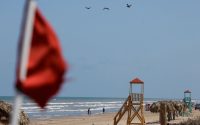What Happens When California Clears Its Homeless Encampments?
Over 171,000 homeless people live in California, more than in any other state in the country. For many Californians facing life without a permanent home, encampments can offer a profound sense of community to people who have little else.
That was the case at Wood Street, an encampment that stretched across several blocks in West Oakland. It had mushroomed into one of the state’s largest, with more than 200 residents at one time. They threw parties for Christmas and birthdays, they installed solar panels and hot-water showers, and they started a community garden.
But some also used drugs together, and Wood Street saw thefts, shootings and more than 200 fires. So California leaders decided last year to clear the camp, despite protests and after a prolonged legal battle.
My colleague Livia Albeck-Ripka spent several months reporting on the Wood Street encampment, and recently published an article about what happened to its residents after the camp had been disbanded.
Democratic leaders in California have begun to lose patience with many of the state’s tent villages and with the blocks of R.V.s that proliferated during the coronavirus pandemic. But it’s not enough, of course, simply to clear the camps. Where will all those homeless residents go?
That’s why the collective fate of the former Wood Street residents is particularly telling. Whether they move into permanent housing or not will help reveal how effectively the state is addressing its homelessness crisis.
I spoke to Livia about her reporting and the seemingly intractable challenge California cities face from homelessness. Here’s our conversation, lightly edited.
Why do you think people were drawn to Wood Street?
Encampments can provide people with physical and emotional security, especially as record numbers of homeless people die on America’s streets. They can also provide people with a sense of agency and stability. That stability is also helpful for the volunteers and resources who serve the unhoused, because they know where to find the people they are working with.
Many former residents of Wood Street said they were actually directed to the site by local authorities, who told them that it was a place where they would be left alone. Many had lived there for several years, and thought of it as their home and their community.
What’s it been like to watch the camp’s evolution over the last year?
Over the past several months, residents have been fighting the clearance of the camp. Throughout that time, I stayed in touch with the residents and the lawyers representing them, as they protested and tried to come up with new ways to halt the eviction. When the residents finally had to leave this spring, many were distressed. Now, some are trying to figure out how to keep their community together.
You wrote that what happens after the closure of Wood Street will serve as a test of how effectively the state is addressing homelessness. How well do you think California is performing on that test?
At this early stage, it’s difficult to say what will become of those who once lived at Wood Street. Some are living in community cabins run by the city. Others are living in R.V. camping sites. Very few have found permanent housing. Many of the experts I spoke with described this kind of temporary shelter as merely a Band-Aid solution that is unlikely to solve homelessness in the long term.
Where we’re traveling
Today’s tip comes from Greta Hambsch, who lives in Genoa, Nev.:
“We frequently find ourselves driving beautiful Highway 395 extending down the spine of California and Nevada. There are so many treasures to see along this highway. It seems to never stop giving. This morning, we were heading east from Bishop. Before starting a short hike to break up a long drive, I found myself finishing my coffee and marveling at a grove of ancient and gnarly trees in the Ancient Bristlecone Pine Forest. Another wonderful surprise.”
Tell us about your favorite places to visit in California. Email your suggestions to [email protected]. We’ll be sharing more in upcoming editions of the newsletter.
And before you go, some good news
Kathi Pugh had an active childhood and often swam and sailed with her father. But then a skiing accident paralyzed her from the chest down.
Pugh thought she would no longer be able to participate in many of her favorite activities. But then came BAADS, the Bay Area Association of Disabled Sailors.
Since 1989, the nonprofit has offered hundreds of rides on specialized boats, specifically designed and adapted to accommodate a range of sailing abilities, The Mercury News reports. Pugh, who uses a power wheelchair, now regularly sails in the middle of the Bay.
“For someone like me, there were very few recreational opportunities available and nothing that was adventurous, had a little bit of danger or a thrill and also took skill,” Pugh told The Mercury News. “After my first trip sailing around Angel Island, I thought, Oh, my gosh, my world has been rocked and will never be the same.”
Thanks for reading. I’ll be back on Monday. Have a nice weekend. — Soumya
P.S. Here’s today’s Mini Crossword.
Briana Scalia and Bernard Mokam contributed to California Today. You can reach the team at [email protected].
Sign up here to get this newsletter in your inbox.


